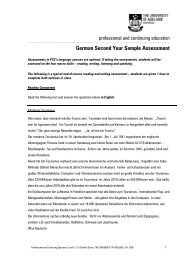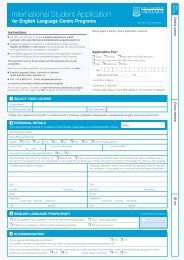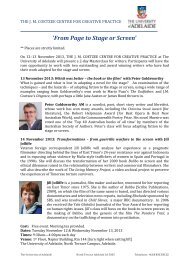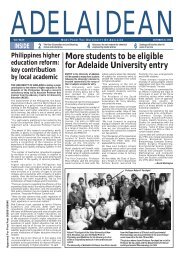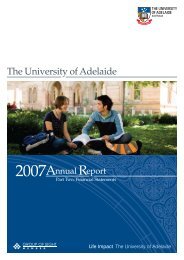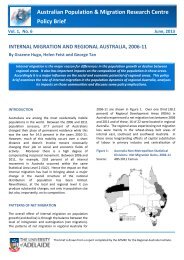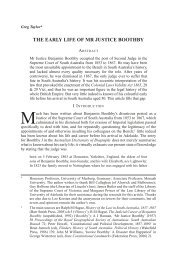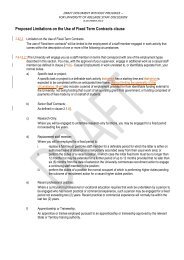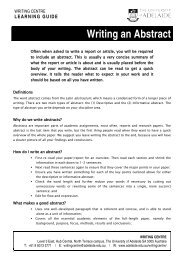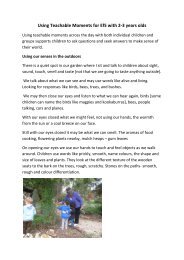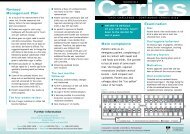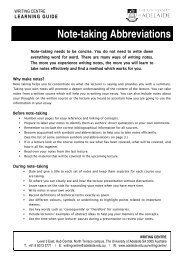Social Networking, Social Media and Complex Emergencies: an ...
Social Networking, Social Media and Complex Emergencies: an ...
Social Networking, Social Media and Complex Emergencies: an ...
Create successful ePaper yourself
Turn your PDF publications into a flip-book with our unique Google optimized e-Paper software.
Bunce, S., Partridge, H. & Davis, K.<br />
(2012) ‘Exploring information experience<br />
using social media during the 2011<br />
Queensl<strong><strong>an</strong>d</strong> Floods: a pilot study’,<br />
Australi<strong>an</strong> Library Journal, vol. 61, no. 1,<br />
pp. 34-45.<br />
Keywords: Australia, floods, monitoring,<br />
awareness.<br />
This paper presents findings from a pilot study on the<br />
information experiences of people using social media<br />
during the Brisb<strong>an</strong>e River flooding in 2010/11. Data<br />
was collected through semi-structured interviews.<br />
Results revealed four different categories describing<br />
particip<strong>an</strong>t experiences:<br />
ƸƸ<br />
ƸƸ<br />
ƸƸ<br />
ƸƸ<br />
Category 1: Monitoring information – use of<br />
social media networks for the purpose of<br />
staying informed<br />
Category 2: Community <strong><strong>an</strong>d</strong> communication<br />
– communities were reached through<br />
established social networking groups or<br />
through traditional media, who sourced<br />
information from response agency social<br />
media platforms<br />
Category 3: Affirmation – information<br />
seeking for affirmation or assur<strong>an</strong>ce (e.g.<br />
safety of family/friends/property) or use of<br />
social media platforms to provide assur<strong>an</strong>ce<br />
of own safety to family <strong><strong>an</strong>d</strong> friends<br />
Category 4: Awareness – development or<br />
exp<strong>an</strong>sion of awareness of <strong>an</strong> event (e.g.<br />
to underst<strong><strong>an</strong>d</strong> how flooding had affected<br />
different areas or ability to attend work).<br />
Results also indicated that the flooding event was<br />
viewed by particip<strong>an</strong>ts as having three distinct<br />
phases: (i) pre-flooding – during this time Category<br />
2 <strong><strong>an</strong>d</strong> 4 information was most useful; (ii) flooding –<br />
Category 3 <strong><strong>an</strong>d</strong> 1 information most useful; <strong><strong>an</strong>d</strong> (3)<br />
post-flooding – Category 2 <strong><strong>an</strong>d</strong> 3 information was<br />
most useful.<br />
Cameron, M.A., Power, R., Robinson, B.<br />
& Yin, J. (2012) Emergency Situation<br />
Awareness from Twitter for crisis<br />
m<strong>an</strong>agement, 21st Annual Conference<br />
on World Wide Web Comp<strong>an</strong>ion,<br />
pp. 695-698.<br />
Keywords: emergency, situation, awareness,<br />
Twitter.<br />
This paper explores ongoing work with the Australi<strong>an</strong><br />
Government to detect, assess <strong><strong>an</strong>d</strong> summarise<br />
messages of interest for crisis coordination<br />
published on Twitter. The paper presents a<br />
description of the Emergency Situation Awareness –<br />
Automated Web Text Mining (ESA-AWTM) <strong><strong>an</strong>d</strong> how it<br />
may be used in emergency m<strong>an</strong>agement scenarios.<br />
The paper explores the problem that while social<br />
media provides a rich source of information about <strong>an</strong><br />
emergency, agency officers have a limited amount of<br />
time to sc<strong>an</strong> <strong><strong>an</strong>d</strong> assess if the information is worthy<br />
of deeper <strong>an</strong>alysis. As a result, tools are needed to<br />
address the following issues (p. 696):<br />
ƸƸ<br />
ƸƸ<br />
ƸƸ<br />
Detect unexpected or unusual incidents,<br />
possibly ahead of official communications<br />
Condense <strong><strong>an</strong>d</strong> summarise messages about<br />
<strong>an</strong> incident maintaining awareness of<br />
aggregated content without having to read<br />
individual messages<br />
Classify <strong><strong>an</strong>d</strong> review high-value messages<br />
during <strong>an</strong> incident (e.g. messages describing<br />
infrastructure damage or cries for help);<br />
underst<strong><strong>an</strong>d</strong> the impact of <strong>an</strong> incident on<br />
people <strong><strong>an</strong>d</strong> infrastructure<br />
<strong>Social</strong> <strong>Networking</strong>, <strong>Social</strong> <strong>Media</strong> <strong><strong>an</strong>d</strong> <strong>Complex</strong> <strong>Emergencies</strong>:<br />
<strong>an</strong> Annotated Bibliography<br />
45



